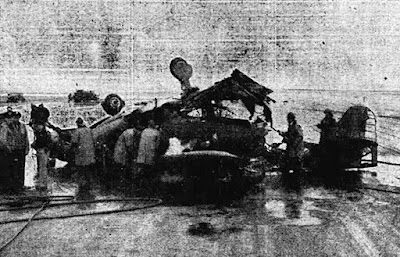WASP Katherine
Applegate Keeler Dussaq. Class 44-W-1.
(1905 – 26 November 1944)
(Excerpt from To Live and Die a WASP)
 |
| WASP Katherine Keeler Dussaq |
The day after WASP
Hazel Lee Louie died (25 November 1944); 39-year-old Kay Dussaq (Class 44-W-1) was in trouble over
Western Ohio. Perhaps it was the freezing rain, the fog, or ice, but at about
8:45 in the evening Kay’s AT-6 was going down near New Carlisle, Ohio. For some
reason, Kay was not wearing her safety harness, and when the plane crashed, she
struck her head on the control stick and died instantly.
Katherine Applegate
was born in Dayton, Washington, March 14, 1905. Hers was an Oregon pioneer
family. In 1846, her great uncle,
Jesse Applegate, had blazed the Applegate
Trail into the Oregon Territory. Her Father, Arthur McClellan Applegate, had
risen from laboring in a flourmill to manager of several flour mills in Oregon
and Washington. He had married Kay’s mother, Clare Moritz, in November 1898.
Kay was their third daughter and grew up in Dayton with her three sisters and
two brothers. After graduation from Harrington High School, she
attended
Whitman College in Walla Walla, Washington, and then the State College of
Washington in Pullman. In 1924, she was one of 70 students out of 700 applicants
accepted by Stanford University, in Palo Alto, California. She graduated in
1927 with a degree in Psychology. |
| WASP Katherine Keeler Dussaq |
In 1929, she and one
of her friends from Stanford, Leonarde Keeler, went to Chicago and began
working at Northwestern University in the Scientific Crime Detection
Laboratory. Kay and Leonarde married, August 14, 1930.
They divorced in May
1941 and the following December Kay married Rene Dussaq. Dussaq was a popular
lecturer. Within days of their marriage, the Japanese bombed Pearl Harbor and
in March 1942, Dussaq enlisted. Kay closed her consulting business and went to
work for the Piper Aircraft Cooperation in Lock Haven, Pennsylvania.
Kay applied to the
WASPs and began training at Avenger Field, August 9, 1943. By graduation the
following February, she had raised her total flying time to over 400 hours. Her
assignment was Sioux Falls Army Base in South Dakota, but soon she transferred
to Randolph Field, near San Antonio, Texas.
 |
| WASP Katherine Applegate Keeler Dussaq |
Because of her flying hours, and
the recognition she had attained during her decade of scientific crime
fighting, at age 39, Kay moved quickly from staff pilot to Coordinator of WASP
activities. Just before her fatal flight, Kay had received another promotion.
She moved to Training Command Headquarters in Houston as WASP Executive for all
three training commands.
After her crash Kay
was returned home for burial in the Dayton, Washington City Cemetery.
RIP































